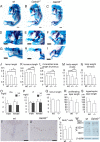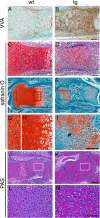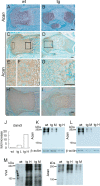Overexpression of Galnt3 in chondrocytes resulted in dwarfism due to the increase of mucin-type O-glycans and reduction of glycosaminoglycans
- PMID: 25107907
- PMCID: PMC4176229
- DOI: 10.1074/jbc.M114.555987
Overexpression of Galnt3 in chondrocytes resulted in dwarfism due to the increase of mucin-type O-glycans and reduction of glycosaminoglycans
Abstract
Galnt3, UDP-N-acetyl-α-D-galactosamine:polypeptide N-acetylgalactosaminyltransferase 3, transfers N-acetyl-D-galactosamine to serine and threonine residues, initiating mucin type O-glycosylation of proteins. We searched the target genes of Runx2, which is an essential transcription factor for chondrocyte maturation, in chondrocytes and found that Galnt3 expression was up-regulated by Runx2 and severely reduced in Runx2(-/-) cartilaginous skeletons. To investigate the function of Galnt3 in chondrocytes, we generated Galnt3(-/-) mice and chondrocyte-specific Galnt3 transgenic mice under the control of the Col2a1 promoter-enhancer. Galnt3(-/-) mice showed a delay in endochondral ossification and shortened limbs at embryonic day 16.5, suggesting that Galnt3 is involved in chondrocyte maturation. Galnt3 transgenic mice presented dwarfism, the chondrocyte maturation was retarded, the cell cycle in chondrocytes was accelerated, premature chondrocyte apoptosis occurred, and the growth plates were disorganized. The binding of Vicia villosa agglutinin, which recognizes the Tn antigen (GalNAc-O-Ser/Thr), was drastically increased in chondrocytes, and aggrecan (Acan) was highly enriched with Tn antigen. However, safranin O staining, which recognizes glycosaminoglycans (GAGs), and Acan were severely reduced. Chondroitin sulfate was reduced in amount, but the elongation of chondroitin sulfate chains had not been severely disturbed in the isolated GAGs. These findings indicate that overexpression of Galnt3 in chondrocytes caused dwarfism due to the increase of mucin-type O-glycans and the reduction of GAGs, probably through competition with xylosyltransferases, which initiate GAG chains by attaching O-linked xylose to serine residues, suggesting a negative effect of Galnt family proteins on Acan deposition in addition to the positive effect of Galnt3 on chondrocyte maturation.
Keywords: Aggrecan; Chondrocyte; Galnt3; Glycosaminoglycan; Glycosyltransferase; Mucin; Mucin-type O-Glycan; Proteoglycan.
© 2014 by The American Society for Biochemistry and Molecular Biology, Inc.
Figures










Similar articles
-
Chondroitin sulfate N-acetylgalactosaminyltransferase 1 is necessary for normal endochondral ossification and aggrecan metabolism.J Biol Chem. 2011 Feb 18;286(7):5803-12. doi: 10.1074/jbc.M110.159244. Epub 2010 Dec 10. J Biol Chem. 2011. PMID: 21148564 Free PMC article.
-
Antxr1, Which is a Target of Runx2, Regulates Chondrocyte Proliferation and Apoptosis.Int J Mol Sci. 2020 Mar 31;21(7):2425. doi: 10.3390/ijms21072425. Int J Mol Sci. 2020. PMID: 32244499 Free PMC article.
-
GlcUAβ1-3Galβ1-3Galβ1-4Xyl(2-O-phosphate) is the preferred substrate for chondroitin N-acetylgalactosaminyltransferase-1.J Biol Chem. 2015 Feb 27;290(9):5438-48. doi: 10.1074/jbc.M114.603266. Epub 2015 Jan 7. J Biol Chem. 2015. PMID: 25568321 Free PMC article.
-
Myriad mechanisms: factors regulating the synthesis of aberrant mucin-type O-glycosylation found on cancer cells.Glycobiology. 2025 Apr 23;35(6):cwaf023. doi: 10.1093/glycob/cwaf023. Glycobiology. 2025. PMID: 40247681 Review.
-
Polypeptide N-acetylgalactosaminyltransferase-Associated Phenotypes in Mammals.Molecules. 2021 Sep 10;26(18):5504. doi: 10.3390/molecules26185504. Molecules. 2021. PMID: 34576978 Free PMC article. Review.
Cited by
-
Alteration of the Total Cellular Glycome during Late Differentiation of Chondrocytes.Int J Mol Sci. 2019 Jul 19;20(14):3546. doi: 10.3390/ijms20143546. Int J Mol Sci. 2019. PMID: 31331074 Free PMC article.
-
Maternal excess dietary phosphate intake in the periconceptional period is a potential risk for mineral disorders in offspring mice.Sci Rep. 2025 Mar 14;15(1):8844. doi: 10.1038/s41598-025-91717-2. Sci Rep. 2025. PMID: 40087383 Free PMC article.
-
Runx2 Regulates Galnt3 and Fgf23 Expressions and Galnt3 Decelerates Osteoid Mineralization by Stabilizing Fgf23.Int J Mol Sci. 2024 Feb 14;25(4):2275. doi: 10.3390/ijms25042275. Int J Mol Sci. 2024. PMID: 38396954 Free PMC article.
-
Genome-wide analysis of endogenously expressed ZEB2 binding sites reveals inverse correlations between ZEB2 and GalNAc-transferase GALNT3 in human tumors.Cell Oncol (Dordr). 2018 Aug;41(4):379-393. doi: 10.1007/s13402-018-0375-7. Epub 2018 Mar 7. Cell Oncol (Dordr). 2018. PMID: 29516288
-
Role of Glycosylation in Vascular Calcification.Int J Mol Sci. 2021 Sep 11;22(18):9829. doi: 10.3390/ijms22189829. Int J Mol Sci. 2021. PMID: 34575990 Free PMC article. Review.
References
-
- Zhao Q., Eberspaecher H., Lefebvre V., De Crombrugghe B. (1997) Parallel expression of Sox9 and Col2a1 in cells undergoing chondrogenesis. Dev. Dyn. 209, 377–386 - PubMed
-
- Gentili C., Cancedda R. (2009) Cartilage and bone extracellular matrix. Curr. Pharm. Des. 15, 1334–1348 - PubMed
-
- Varki A., Cummings R. D., Esko J. D., Freeze H. H., Stanley P., Bertozzi C. R., Hart G. W., Etzler M. E. (eds) (2009) Essentials of Glycobiology, pp. 229–248, Cold Spring Harbor Laboratory Press, Cold Spring Harbor, NY - PubMed
Publication types
MeSH terms
Substances
LinkOut - more resources
Full Text Sources
Other Literature Sources
Medical
Molecular Biology Databases

